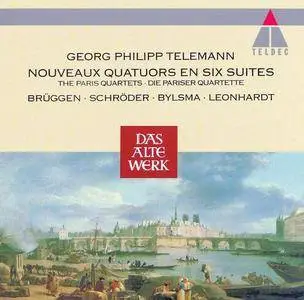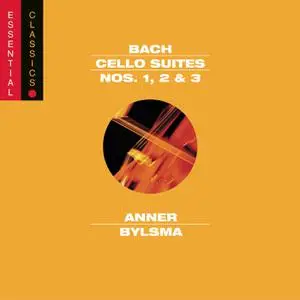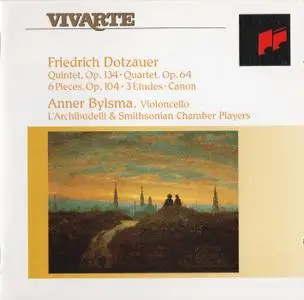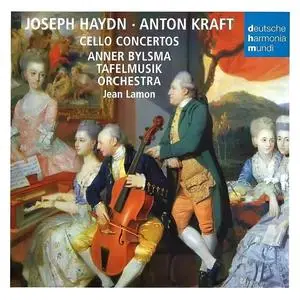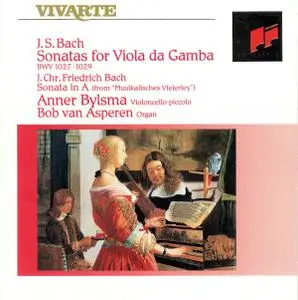Anner Bylsma
Vivaldi - 6 Sonatas for violoncello & b.c. (Anner Bylsma) [2014 / 2009] Music
Posted by Sowulo at May 12, 2014
Vivaldi - 6 Sonatas for violoncello & b.c. (Anner Bylsma) [2014 / 2009]
EAC Rip | FLAC, IMG+CUE, LOG | Covers | 1cd, 281 MB
Classical | Label: DHM | Catalog Number: 88843 02161 | TT: 61’38"
EAC Rip | FLAC, IMG+CUE, LOG | Covers | 1cd, 281 MB
Classical | Label: DHM | Catalog Number: 88843 02161 | TT: 61’38"
Anner Bylsma (born Anne Bijlsma 17 February 1934, The Hague) is a Dutch cellist who plays on both modern, and period instruments in a historically informed style. He took an interest in music from an early age. He studied with Carel van Leeuwen Boomkamp at the Royal Conservatory of The Hague and won the Prix d'excellence in 1957.
Anner Bylsma, Jeanne Lamon, Tafelmusik - Luigi Boccherini: Concertos, Overture, Octet, Sinfonia (1993) Music
Posted by ArlegZ at Jan. 13, 2025
Anner Bylsma, Jeanne Lamon, Tafelmusik - Luigi Boccherini: Concertos, Overture, Octet, Sinfonia (1993)
EAC | FLAC | Image (Cue & Log) ~ 346 Mb | Total time: 69:13 | Scans included
Classical | Label: Sony Classical | # SK 53121 | Recorded: 1992
EAC | FLAC | Image (Cue & Log) ~ 346 Mb | Total time: 69:13 | Scans included
Classical | Label: Sony Classical | # SK 53121 | Recorded: 1992
This disc offers very enjoyable selection of Boccherini. The two symphonies are late works, the D major a single-movement piece of the Italian overture type, with a slow movement embedded, the C minor his most 'symphonic' work in the Viennese-classical sense of the term. Jeanne Lamon directs lively performances with this excellent Canadian group. The D major she takes rather quickly, producing that sense of tension that arises when music is pushed a little beyond its natural pace; but the effect is energetic and inspiriting (and it is marked con molto spirito). The Andantino is more relaxed, its colours happily realized.
Anner Bylsma, Bob Van Asperen - Bach: Sonatas for Viola da Gamba (1990) [Japan 2019] SACD ISO + DSD64 + Hi-Res FLAC Vinyl & HR
Posted by HDAtall at Dec. 19, 2024
Anner Bylsma, Bob Van Asperen - J.S. Bach: Sonatas For Viola Da Gamba BWV 1027-1029 & J.C.F. Bach:
J.C.F. Bach: Sonata for Violoncello and Basso continuo (From "Musikalisches Vielerley") (1990) [Japan 2019]
SACD Rip | SACD ISO | DST64 2.0 > 1-bit/2.8224 MHz | 51:08 minutes | Front/Rear Covers | 1,47 GB
or DSD64 2.0 (from SACD-ISO to Tracks.dsf) > 1-bit/2.8224 MHz | Front/Rear Covers | 1,3 GB
or FLAC (carefully converted & encoded to tracks) 24bit/48 kHz | Front/Rear Covers | 543 GB
Cellist Anner Bylsma is joined by organist Bob van Asperen for this recording of compositional works by Johann Sebastian Bach alongside a piece by Johann Christoph Friedrich Bach from "Musikalisches Vielerley". Originally this recording has been processed using 20-bit technology to maximize sound quality.
Frans Bruggen, Jaap Schroder, Anner Bylsma, Gustav Leonhardt - Telemann: Nouveaux Quatuors en Six Suites (1993) Music
Posted by tirexiss at March 4, 2023
Frans Bruggen, Jaap Schroder, Anner Bylsma, Gustav Leonhardt - Telemann: Nouveaux Quatuors en Six Suites (1993)
EAC FLAC (image+.cue, log) | Covers Included | 02:24:10 | 859 MB
Genre: Classical | Label: Teldec | Catalog: 4509-92177-2
EAC FLAC (image+.cue, log) | Covers Included | 02:24:10 | 859 MB
Genre: Classical | Label: Teldec | Catalog: 4509-92177-2
In the Telemann mountains, much of the topography remains terra incognita because most of Telemann's music remains an undiscovered country. But whatever future generations of hardy musicologists may uncover, it is unlikely that Telemann's Nouveaux Quatuors en Six Suites published in Paris in 1738 will be displaced as among his output's highest peaks.
Anner Bylsma - J.S. Bach: Cello Suites Nos. 1, 2 & 3 (1999) Music
Posted by tirexiss at March 18, 2022
Anner Bylsma - J.S. Bach: Cello Suites Nos. 1, 2 & 3 (1999)
WEB | FLAC (tracks) - 281 MB | 54:57
Genre: Classical | Label: Sony Classical
WEB | FLAC (tracks) - 281 MB | 54:57
Genre: Classical | Label: Sony Classical
To those of you who are chary of "historically informed" interpretations, you needn't be in this case. Though presumably Bylsma's approach is scholarly and "correct", there is nothing objective about his interpretation. It is sinewy, chocolately, dramatic, as winning and hearfelt an interpretation as any of the great performances on the modern cello by Cassals, Fournier, Rostropovich et al. Bylsma uses an actual period cello, not a reproduction, but manages to bring it alive and to coax out of it the sweetest sounds. Bylsma's tempi are faster than those familiar with modern interpretations might be prepared for, but his musicianship is so keen that the most precise phrasing remains intact and Bach's music never ends up sounding forced or rushed.
Anner Bylsma, L'Archibudelli & Smithsonian Chamber Players - Dotzauer: Quintet, Pieces for cello, Quartet (1995) Music
Posted by tirexiss at Jan. 10, 2022
Anner Bylsma, L'Archibudelli & Smithsonian Chamber Players - Dotzauer: Quintet, Pieces for cello, Quartet (1995)
EAC | FLAC (image+.cue, log) | Covers Included | 73:56 | 413 MB
Genre: Classical | Label: Sony Classical | Catalog: 64307
EAC | FLAC (image+.cue, log) | Covers Included | 73:56 | 413 MB
Genre: Classical | Label: Sony Classical | Catalog: 64307
In his day, Friedrich Dotzauer (1783-1860) was extremely influential as a performer, teacher and composer. In addition to having a highly successful career as an orchestral player. Dotzauer taught many of the best-known cellists of his age, and was prolific as a composer of sacred music, symphonies and chamber music. This issue makes available a sample of Dotzauer's chamber music which reveals the composer's craftsmanship and rich imagination. The four-movement Quintet. Op. 134 has an easy grace and carefree melodiousness that Bylsma and his colleagues express most engagingly.
Anner Bylsma, Jean Lamon, Tafelmusik Baroque Orchestra - Joseph Haydn, Anton Kraft: Cello Concertos (1990) Music
Posted by ArlegZ at April 16, 2023
Anner Bylsma, Jean Lamon, Tafelmusik Baroque Orchestra - Joseph Haydn, Anton Kraft: Cello Concertos (1990)
EAC | FLAC | Image (Cue & Log) ~ 341 Mb | Total time: 66:34 | Scans included
Classical | Label: Deutsche Harmonia Mundi | # 7757-2-RC | Recorded: 1989
EAC | FLAC | Image (Cue & Log) ~ 341 Mb | Total time: 66:34 | Scans included
Classical | Label: Deutsche Harmonia Mundi | # 7757-2-RC | Recorded: 1989
An album overflowing with musical joy that transcends the composer. It is clear from the first sound of the CD and fills the space of the listening room brightly. A brilliance and lively fulfillment that rivals Mozart's finest moments. Anner Bylsma's cello tone and wonderful performance using period instruments, Melting with it, it progresses while adding luster, brilliance and dynamism.
Anner Bylsma, Bob van Asperen - J.S. Bach: Sonatas for Viola da Gamba, J.C.F. Bach: Sonata A-Dur (1990) Music
Posted by tirexiss at Aug. 1, 2023
Anner Bylsma, Bob van Asperen - J.S. Bach: Sonatas for Viola da Gamba, J.C.F. Bach: Sonata A-Dur (1990)
EAC | FLAC (image+.cue, log) | Covers Included | 51:22 | 500 MB
Genre: Classical | Label: Sony Classical | Catalog: SK 45945
EAC | FLAC (image+.cue, log) | Covers Included | 51:22 | 500 MB
Genre: Classical | Label: Sony Classical | Catalog: SK 45945
That said, Anner Bylsma's disc gets a great deal more playing time. The timbre of the piccolo cello is ideally matched with the organ. While purists may balk at such unusual instrumentation, I cannot help but think such an experiment is quite in keeping with the spirit of Baroque era practices. In general, I try not to judge the success of a recording by a preconceived idea of what a musical elite would or would not approve of.
Anner Bylsma plays Boccherini: Cello Concertos & Sonatas, Fugues, String Quintets, Symphonies [5CDs] (2010) Music
Posted by ArlegZ at July 20, 2024
Anner Bylsma plays Boccherini: Cello Concertos & Sonatas, Fugues, String Quintets, Symphonies [5CDs] (2010)
EAC | FLAC | Image (Cue & Log) ~ 1.58 Gb | Total time: 05:57:05 | Scans included
Classical | Label: Sony Classical | # 88697685192 | Recorded: 1977, 1988, 1992
EAC | FLAC | Image (Cue & Log) ~ 1.58 Gb | Total time: 05:57:05 | Scans included
Classical | Label: Sony Classical | # 88697685192 | Recorded: 1977, 1988, 1992
Though born in Italy, Luigi Boccherini was based for most of his life in Madrid, where he played the cello and wrote more than a hundred string quintets. They’re perfectly formed from the simplest chords, and not without their touches of profundity. The cello sonatas sound at times too much like performers’ music. The explanation lies in changing styles of string technique and the rise of the piano, though Anner Bylsma’s playing gives them a new lease of life.
Anner Bylsma, Bob van Asperen - J.S. Bach: Sonatas for Viola da Gamba, J.C.F. Bach: Sonata A-Dur (1990) Music
Posted by tirexiss at March 25, 2024
Anner Bylsma, Bob van Asperen - J.S. Bach: Sonatas for Viola da Gamba, J.C.F. Bach: Sonata A-Dur (1990)
EAC | FLAC (image+.cue, log) | Covers Included | 51:22 | 500 MB
Genre: Classical | Label: Sony Classical | Catalog: SK 45945
EAC | FLAC (image+.cue, log) | Covers Included | 51:22 | 500 MB
Genre: Classical | Label: Sony Classical | Catalog: SK 45945
That said, Anner Bylsma's disc gets a great deal more playing time. The timbre of the piccolo cello is ideally matched with the organ. While purists may balk at such unusual instrumentation, I cannot help but think such an experiment is quite in keeping with the spirit of Baroque era practices. In general, I try not to judge the success of a recording by a preconceived idea of what a musical elite would or would not approve of.
![Vivaldi - 6 Sonatas for violoncello & b.c. (Anner Bylsma) [2014 / 2009]](https://pixhost.icu/avaxhome/c0/c4/002cc4c0_medium.jpeg)
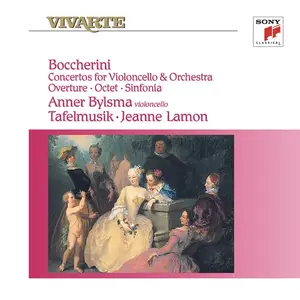
![Anner Bylsma, Bob Van Asperen - Bach: Sonatas for Viola da Gamba (1990) [Japan 2019] SACD ISO + DSD64 + Hi-Res FLAC](https://pixhost.icu/avaxhome/96/9621/9621917517ff4b49a5203641cd4c4a82-756420672990956923_medium.webp)
